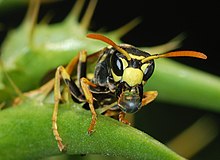Regurgitation


The regurgitation ( lat. Re "back", Gurges "throat") is a process in which the contents of hollow organs (such as the chyme in the stomach and esophagus , or blood in the heart does not take) the commonly designated route, but back in the other direction flows. This process is pathological in humans and in many animal species, but in some species (mainly insects) it is normal and vital.
Regurgitation in humans and other mammals
As regurgitation returning penetration of solid or liquid food portions from the stomach into the esophagus and into which the mouth referred to immediately after the ingestion of certain diseases of the esophagus, as described for example in insufficiency of the upper or lower sphincter (sphincter) of the esophagus, achalasia , or occurs in Zenker's diverticula . Unlike vomiting , this happens passively, not through anti-peristalsis . In dogs, regurgitation is a key symptom of a megaesophagus .
In the event of unconsciousness , including dementia , there is a risk that the food residues will find their way into the trachea or bronchi, triggering aspiration and pneumonia (see also aspiration pneumonia ) up to ARDS . In the worst case scenario, you can choke on inhalation of vomit or regurgitated matter. The first aid measure of stable lateral position with the head overstretched is intended to reduce this risk; however, endotracheal intubation is the only largely safe measure to secure the airway and prevent aspiration .
In cardiology , the backflow of blood in the case of valve insufficiency of the heart is also referred to as regurgitation .
Regurgitation in birds
Numerous bird species regurgitate indigestible food residues as so-called vaults or spits . Some birds collect the food for their young birds in the crop and choke it out of it when they are fed.
In birds, pathological regurgitation often occurs with goiter inflammation or goiter stones .
Regurgitation in the insect world
When an ant is touched by the antennae , it chokes out existing food, which the contacting ant then eats. This process is also called regurgitation. In this way, a source of food can be distributed to all individuals of an ant colony in less than half an hour.
A fly regurgitates a degrading enzyme on its potential food in order to digest it outside of its body. Then the liquefied food is sucked into the trunk together with the enzyme. Flies do not have a stomach and therefore no other way to ingest structured food.
Individual evidence
- ↑ B. König, D. Reinhardt, H.-P. Schuster: Compendium of practical medicine . Springer-Verlag, March 7, 2013, ISBN 978-3-642-59754-1 , p. 5.
- ^ The Merck Veterinary Manual. 9th edition. Whitehouse Station NJ, ISBN 978-0-911910-50-6 , p. 134.
- ↑ Meindest Haveman, Reinhilde Stöppler: Kohlhammer (Ed.): Health and Illness in People with Mental Disabilities 2014, ISBN 978-3-1-020912-1.
- ↑ Rüdiger Meyer: mitral regurgitation after myocardial infarction: mitral valve repair parallel to coronary artery bypass graft without advantages . Retrieved July 29, 2016.
- ↑ Petra Wolf et al .: A goiter in the budgie (Melopsittacus undulatus) . In: Kleintierpraxis 40 (1995), pp. 301-308.